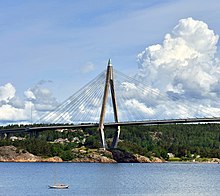Uddevallabron
Coordinates: 58 ° 19 ′ 30 ″ N , 11 ° 50 ′ 44 ″ E
| Uddevallabron | ||
|---|---|---|
| South view | ||
| Official name | Sunningesundsbron | |
| use | Road bridge, 4 lanes | |
| Convicted | Europastraße 6 | |
| Crossing of | Sunningesund | |
| place | Sunninge, Uddevalla | |
| Entertained by | Trafikverket | |
| overall length | 1712 m | |
| width | 23.3 m | |
| Longest span | 414 m | |
| height | 149 m | |
| Clear height | 51 m | |
| vehicles per day | 10,000 vehicles | |
| start of building | 1997 | |
| completion | 2000 | |
| opening | May 20, 2000 | |
| toll | No | |
| location | ||
|
|
||
The Uddevallabron is a double-hip cable - stayed bridge near the Swedish city of Uddevalla . It spans a branch of the Sunningesund, which separates the island of Orust from the mainland. The motorway bridge on the west coast of Sweden was built as a result of the re-routing of European route 6 , which, as a bypass, relieves the city of Uddevalla and at the same time shortens the route by 12.8 kilometers. With a length of 1712 meters, it is the longest cable-stayed bridge that is entirely located on Swedish territory and, after the Öresund Bridge, the second longest motorway bridge in the country.
technology
The Norwegian company Johs Holt AS and the Swedish Skanska Teknik AB received the contract for the structural engineering . Skanska was a general contractor and employed several subcontractors. Alpin Technik und Ingenieurservice GmbH and VSL International were responsible for the cables , Mageba for the bridge bearings and Peri for the formwork and scaffolding.
The access ramps to the main bridge were built using incremental launching . After the bridge had been pushed in, the incremental sliding bearings were converted into permanent bridge bearings through minor adjustments. The vertical loads on the bridge bearings range between 5,500 kN and 15,300 kN. The horizontal forces are 1,900 kN.
The cable girders are made of steel, the deck girder and the pylons are made of reinforced concrete . The two pylons each take the load on two hips through the fan-shaped steel cables. A total of 9,000 tons of steel and 35,000 cubic meters of concrete were used for the Uddevalla Bridge. The bridge structure and its connection cost around 900 million Swedish kronor in 2000 , which corresponds to a purchasing power value of around 100 million euros.
In the past, the bridge had to be closed occasionally because of ice trapped in the stay cables. A method was investigated to de-ice the ropes by means of electrical impulses. But this turned out to be too expensive. Overall, however, this is a negligible problem, as the Swedish road administration announced, since the availability of the bridge is almost 100 percent.
Key data
The longest span of the 1712 meter long bridge is 414 meters. The two rhombic A-pylons tower 149 meters high. The two concrete pylons are closed with metal truncated pyramids in which the flight lights are located. The clear height is 51 meters.
literature
- Niels J. Gimsing: Cable Supported Bridges: Concept and Design , John Wiley & Sons, 2012, ISBN 978-0-470-66628-9 , p. 131.
- Holger Svensson: Cable-Stayed Bridges: 40 Years of Experience Worldwilde , Ernst & Sohn, Berlin 2012, ISBN 978-3-433-02992-3 , pp. 114f, 164, 262, 265, 450f.
Web links
Individual evidence
- ↑ Uddevallabron invigs. In: nyteknik.se , May 19, 2000, accessed July 5, 2017
- ↑ Uddevalla Bridge. In: mageba-germany.de , accessed on July 5, 2017
- ↑ Is stoppar trafik på Uddevallabron. In: gp.se , March 26, 2008, accessed on July 5, 2017

